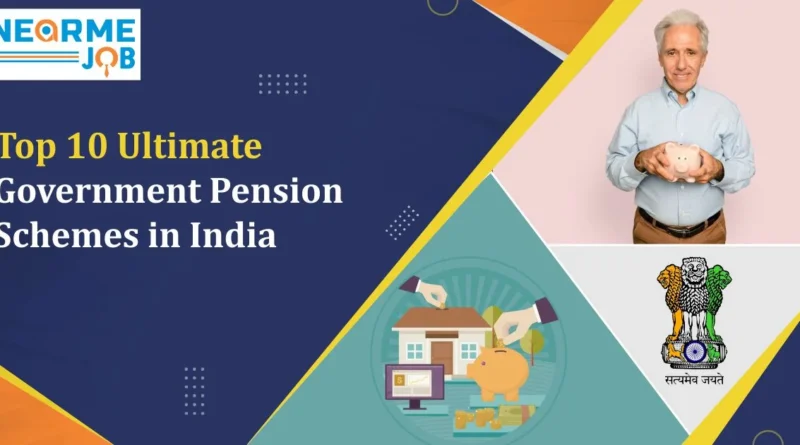Top 10 Ultimate Government Pension Schemes in India
Retirement planning isn’t just about saving, it’s about securing and independence in a country where nearly 90% of the work operates in the informal sector, lacking access to structured social security.
With India’s elderly population projected to double to 20% by 2050, government pension schemes have become a lifeline for millions.
From market-linked plans to assured income for marginalized workers, these programs bridge the gap between financial security and stability.
Government Pension Schemes for Senior Citizens
India’s pension ecosystem is a well mixture of welfare and money making. While schemes like the NPS refers to salaried professionals wanting growth, initiatives like PM-SYM and APY prioritize inclusivity for street vendors, farmers, and domestic workers.
Together, they address a critical need: only 12% of Indians currently have retirement coverage. Recent reforms, such as digital enrollment and higher budgetary allocations, reflect the government’s push to expand this safety net.

Also read this 👉 Government Jobs vs Private Jobs: 10 Key Differences Explained Job Benefits in India
Here’s a breakdown of the most prominent govt pension schemes.
National Pension System (NPS)
The NPS isn’t just a pension plan—it’s a money-building tool with duo benefits of market returns and tax savings.
Indian Citizen can choose between Tier 1 (locked until retirement) and Tier 2 (withdrawals free), making it ideal for both disciplined money savers and those seeking liquidity.
Who Should Join for NPS?
- Young professionals: Starting at age 18 allows decades of compounding.
- Freelancers: Voluntary contributions align with irregular incomes.
- Corporates: Many employers match employee contributions (e.g., a 10% salary deduction + 10% employer top-up).
2024/25 Updates:
- Auto-portability: Seamlessly transfer your NPS account when switching jobs—no paperwork.
- New Fund Managers: ICICI Pru Pension Fund and HDFC Pension now offer aggressive equity options for higher returns.
Tip: Use the NPS calculator on the CRAs (NSDL/KFinTech) to estimate your corpus. For example, a 30-year-old investing ₹5,000/month at 10% returns could accumulate ₹2.4 crore by the age of 60!
Atal Pension Yojana (APY)
The APY is a game-changer for gig workers, maids, and small traders. Unlike volatile market plans, it guarantees fixed pensions ranging from ₹1,000 to ₹5,000/month.
How Does the Co-Contribution Work?
If you join before December 31, 2023, the government adds ₹1,000/year to your account for five years, effectively doubling your initial savings. For example, a 25-year-old contributing ₹126/month for ₹3,000/month pension would receive an extra ₹5,000 from the government by age 30.
Exit Plan:
While the pension starts at 60, you can exit early in cases of critical illness. However, only your contributions (not the government’s) are refunded.
PM Shram Yogi Maan-dhan (PM-SYM)
Especially made for laborers earning less than ₹15,000/month, PM-SYM ensures ₹3,000/month post-60. The sliding contribution scale adjusts with age:
| Age at Enrollment | Monthly Contribution |
| 18 | ₹55 |
| 30 | ₹120 |
| 40 | ₹200 |
Spousal Protection: If a subscriber dies, the spouse receives 50% of the pension.
Tech Upgrades: The 2023 integration with UMANG App allows contributions via UPI, reducing dependency on bank visits.
For Example: Rani, a 35-year-old construction worker, invests ₹150/month. By 60, she’ll receive ₹3,000/month—enough to cover her medical bills and groceries.
Indira Gandhi National Old Age Pension Scheme (IGNOAPS)
IGNOAPS major target audience are seniors below the poverty line, offering ₹200–500/month. While modest, it’s a critical support for those without savings.
State Collaborations with IGNOAPS:
- Kerala: Adds ₹1,300 to the central ₹500, granting ₹1,800/month to 80+ seniors.
- Delhi: Offers free healthcare and travel concessions alongside pensions.
Cons: Delays in BPL certification often hinder access. Activists urge states to adopt Aadhaar-based auto-enrollment.
Senior Citizens’ Savings Scheme (SCSS)
The SCSS is a favorite among retirees for its fixed 8.2% interest (Q2 2024) and tax benefits. Unlike volatile markets, it ensures quarterly income.
Maximize Returns from SCSS:
Invest ₹30 lakh (max limit) to earn ₹1.64 lakh/year in interest.
Combine with PMVVY (Pradhan Mantri Vaya Vandana Yojana) for an extra ₹10,000/month.
Tip: Interest is taxable on investments. Consult a CA to optimize tax under Section 80C.
Looking for quick hiring roles? Explore Urgent Job Openings in Ahmedabad 2025 across top sectors like finance, support, and fieldwork—apply today!
Unified Pension Portal
Launched in 2022, the portal (https://pensionersportal.gov.in) now integrates 11 state pension schemes, including Kerala’s Welfare Fund Board and Tamil Nadu’s Old Age Pension. Includes:
- Pension Tracker: Real-time status updates.
- Grievance Redressal: Resolve issues within 15 days via the portal’s chatbot.
- e-PPO: Download your Pension Payment Order online.
Application Process for Pension Schemes
Online:
- NPS: Upload Aadhaar, PAN, and a photo on eNPS. Choose between Active (self-managed) or Auto (lifecycle-based) funds.
- APY: Link your Jan Dhan account for auto-debit via the APY app.
Offline:
- PM-SYM: Visit a Labour Office or CSC with an income certificate (attested by MLA/MP for faster processing).
Common Issues:
- Document Errors: Mismatched Aadhaar and bank details delay approvals. Cross-check beforehand.
- KYC Pending: Complete video KYC within 30 days of enrollment.
Final Word: Your Retirement, Your Responsibility
Government schemes are tools—how you use them defines your future. A 25-year-old investing ₹1,000/month in NPS could retire at 60 with ₹2.9 crore, while a 40-year-old joining APY secures ₹5,000/month for life.
Act now—visit your nearest CSC or log on to the Unified Portal. Your future self will thank you.
[html_block id=”238″]

